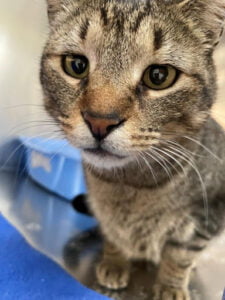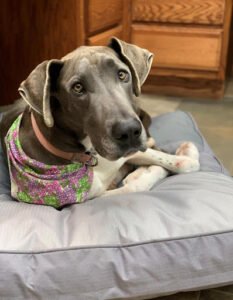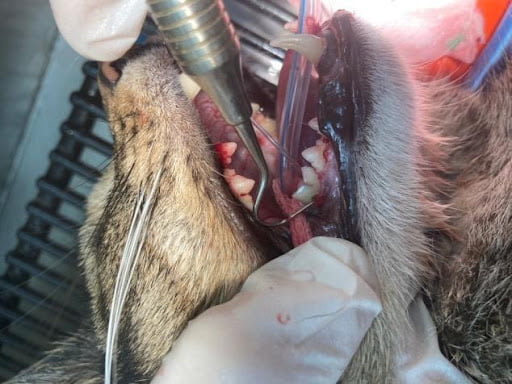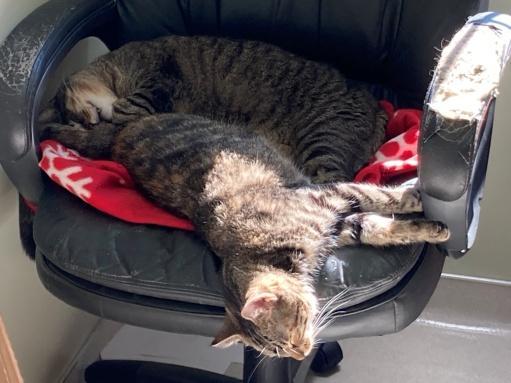By Dr. Elizabeth Belyew
What do P.C. and Ivy have in common?
A. Dr. Elizabeth’s pets
B. Primarily gray in color
C. “Soulful” eyes
D. Stinky, foul breath
E. Grateful to Dr. Elizabeth for relieving their tooth pain
F. All the above

P.C.

Ivy
Correct Answer: F
Once upon a time, P.C. was a feral cat that we trapped outside the clinic. After testing negative for feline leukemia and feline immunodeficiency viruses, being neutered and vaccinated we released him back to the wild. However, he took up residence on our clinic’s front porch. Our staff fed him daily (too much) and gave him a comfy bed. But he would not let us near him. David, CAC OM, and feline liaison, patiently and determinedly spent a year gaining his trust and making friends. Now you will most likely see P.C. running in and out of the clinic when you visit. That is he goes in and out, in and out, in and out……….all day long. When he is not outside hunting field rats or inside playing with his pal Charlie he naps in his own office chair in David’s office. Sometimes nap time is with Charlie.
One day David told me that P.C.’s breath smelled like “death”. He was not playing with Charlie or wanting to go outside. Something was obviously wrong! I lifted those lips and examined his oral cavity and teeth and discovered he had a very painful feline tooth condition called feline resorptive lesion (FPL). FPLs cause holes in the teeth resulting in exposure of the nerves and blood vessels. Ouch!! Approximately 60% of cats will have at least one FPL by the time they are 6 years old. Once I had P.C. under general anesthesia and performed full mouth dental radiographs I discovered several FPLs. Some were very large. Complete surgical extraction of the affected teeth is the only treatment for this painful, debilitating condition. I surgically extracted all of P.C’s diseased teeth.
Not only did P.C.’s stinky breath disappear but he started playing with Charlie and hunting again – in and out, in and out, in and out…….
 .
.
Many pet owners think their pet’s inactivity and laziness is due to them getting older. However, many times it is because of pain from diseased teeth or periodontal disease. Once we provide appropriate treatment most pets become much more active and playful. Amazingly, most pets continue to eat even with advanced periodontal disease and tooth pain. Therefore, it is critical to have your pets examined at least once a year by a licensed veterinarian.


Ivy, my 4-year-old Great Dane, suddenly developed stinky breath. I lifted those huge lips to see what was hiding in there! A dental exam and radiographs under general anesthesia revealed the periodontal disease of three front bottom teeth (incisors). Plaque formation on the teeth can cause bone loss around the teeth and damage to the periodontal ligament. I extracted the diseased teeth, scaled the calculus, and polished all the other teeth. Her breath is now much more pleasant. I brush her teeth and gums most every morning now to keep her remaining teeth healthy.
Oral health care is crucial to your pet’s comfort, health, and quality of life. Appropriate dental care for our pets starts with an exam and treatment plan. Nothing says “I love you” more than committing to doing everything within your means to eliminate existing pain and guard against future pain. The mouth is a major source of disease and pain for our pets. That is why every pet needs a thorough exam of their oral cavity at least once a year.
Let’s play Truth or Dare!
Truth: What is hiding behind your pet’s lips?
Dare: Lift those lips! Take a whiff!
Better yet, schedule an exam and let me and my staff take the dare and tell you the truth.

